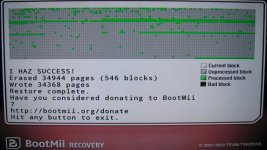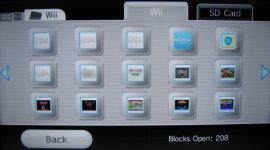tl;dr: When you restore from a bootmii NAND backup, it only restores the sectors that are different rather than the entire NAND, and I would like to instead restore the entire NAND including the sectors that have not changed—I do not care about minimizing unnecessary writes to the NAND.
————————————————————————————————————————————————————————————————
Every detail and the kitchen sink
A couple of month ago, I noticed that some 8GB USB flash drives that my father got from his workplace around a decade ago started suffering from bit rot (verified using SHA1 checksums of all of the files on the disk), presumably because I think these drives were made in that narrow point in time after TLC NAND became a thing but before 3D NAND became a thing, making their flash memory sort of the worst of both worlds (this if evidenced in that they're the slowest USB disks I own, even more-so than old flash disks measured in megabytes).
This got me thinking about bit rot in general for flash memory and, from some tests using the aforementioned USB disks that were suffering from bit rot, I found that having the disks receive power only slows down bit rot rather than stopping it (and heat seems to accelerate bit rot). Since I'm a bit OCD about backups and data retention (hence the aforementioned use of SHA1 checksums), it was easy for me to go around and refresh the sectors of all of the flash memory disks and SSDs that I own, even including my soft-modded 3DS.
...but the Wii is a different story because, when you restore from a bootmii NAND backup, it only restores the sectors that are different rather than the entire NAND. I imagine this was done simply because it's faster and helps prevent unnecessary wear on the Wii's NAND, but it'd be nice if you could still do some sort of override and forcefully restore the entire NAND.
Thing is though, I really don't want to straight-up format the system memory then subsequently restore its NAND since, I'll be honest, I have no idea if formatting the Wii would still allow me to go into bootmii like normal and restore the NAND, or if it'll be treated like a different Wii afterwards and I won't be able to restore the NAND, or if formatting it will even make it difficult to get back into bootmii in the first place, so it seems safer to just not even humor the "format system memory" route.
If worst comes to worst I figured I could just try making a new bootmii NAND backup, then restoring from the oldest bootmii NAND backup I still have on hand, and then re-restoring that newly-created boomii NAND backup. It possibly won't overwrite the entire NAND (heck it might not even overwrite half of it since the arrangement of channels I've had installed on the system memory hasn't really changed in like a decade), but it's still better than nothing.
At the very least, my console is a launch-day Wii system so the NAND can't be any smaller than 90nm since that was the node used for the CPU, meaning the NAND is going to be using a node that's at least equal to or larger than 90nm (I wouldn't even be surprised if the NAND used something like a 130nm node). Furthermore, since TLC NAND wasn't even a thing yet, it'll be at least MLC NAND if not straight-up SLC NAND (I'm unsure if MLC NAND was actually available in consumer products at that time since consumer SSDs weren't even a thing yet which is what really popularized MLC NAND). Therefore, this combination of a relatively huge-sized manufacturing node combined with at least MLC NAND if not SLC NAND means that the unpowered data retention time for my Wii's NAND should in theory be a ridiculous amount of time anyway (i.e. decades).
————————————————————————————————————————————————————————————————
Every detail and the kitchen sink
A couple of month ago, I noticed that some 8GB USB flash drives that my father got from his workplace around a decade ago started suffering from bit rot (verified using SHA1 checksums of all of the files on the disk), presumably because I think these drives were made in that narrow point in time after TLC NAND became a thing but before 3D NAND became a thing, making their flash memory sort of the worst of both worlds (this if evidenced in that they're the slowest USB disks I own, even more-so than old flash disks measured in megabytes).
This got me thinking about bit rot in general for flash memory and, from some tests using the aforementioned USB disks that were suffering from bit rot, I found that having the disks receive power only slows down bit rot rather than stopping it (and heat seems to accelerate bit rot). Since I'm a bit OCD about backups and data retention (hence the aforementioned use of SHA1 checksums), it was easy for me to go around and refresh the sectors of all of the flash memory disks and SSDs that I own, even including my soft-modded 3DS.
...but the Wii is a different story because, when you restore from a bootmii NAND backup, it only restores the sectors that are different rather than the entire NAND. I imagine this was done simply because it's faster and helps prevent unnecessary wear on the Wii's NAND, but it'd be nice if you could still do some sort of override and forcefully restore the entire NAND.
Thing is though, I really don't want to straight-up format the system memory then subsequently restore its NAND since, I'll be honest, I have no idea if formatting the Wii would still allow me to go into bootmii like normal and restore the NAND, or if it'll be treated like a different Wii afterwards and I won't be able to restore the NAND, or if formatting it will even make it difficult to get back into bootmii in the first place, so it seems safer to just not even humor the "format system memory" route.
If worst comes to worst I figured I could just try making a new bootmii NAND backup, then restoring from the oldest bootmii NAND backup I still have on hand, and then re-restoring that newly-created boomii NAND backup. It possibly won't overwrite the entire NAND (heck it might not even overwrite half of it since the arrangement of channels I've had installed on the system memory hasn't really changed in like a decade), but it's still better than nothing.
At the very least, my console is a launch-day Wii system so the NAND can't be any smaller than 90nm since that was the node used for the CPU, meaning the NAND is going to be using a node that's at least equal to or larger than 90nm (I wouldn't even be surprised if the NAND used something like a 130nm node). Furthermore, since TLC NAND wasn't even a thing yet, it'll be at least MLC NAND if not straight-up SLC NAND (I'm unsure if MLC NAND was actually available in consumer products at that time since consumer SSDs weren't even a thing yet which is what really popularized MLC NAND). Therefore, this combination of a relatively huge-sized manufacturing node combined with at least MLC NAND if not SLC NAND means that the unpowered data retention time for my Wii's NAND should in theory be a ridiculous amount of time anyway (i.e. decades).
Last edited by Nintendo Maniac,





